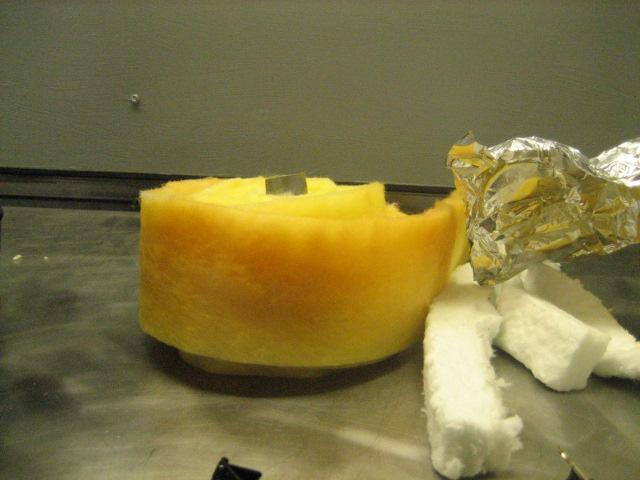Magpie
lab constructor
    
Posts: 5939
Registered: 1-11-2003
Location: USA
Member Is Offline
Mood: Chemistry: the subtle science.
|
|
insulation
Below is a picture of some insulation used to lag water pipes to keep them from freezing. I bought this as it was cheap and came in a very convenient
form, ie, a strip 1/2"x3"x25'. However, in use it discolored from a yellow to an orange as you can see. Temperature of use was ~200C.
I'm supposing that an organic binder was decomposing as there was a little smoke emitted also when used. Does anyone know?
Does this mean that ordinary building trade type insulation is likely not suitable at this temperature and that I will have to go to lab grade
fiberglass wool or kaowool? Any other suggestions?

The single most important condition for a successful synthesis is good mixing - Nicodem
|
|
|
aonomus
Hazard to Others
  
Posts: 361
Registered: 18-10-2009
Location: Toronto, Canada
Member Is Offline
Mood: Refluxing
|
|
As far as I know, most fiberglass batts come with some sort of binder or glue to help hold it together during manufacturing and handling during
installation, and these might be prone to offgassing. Your best bet would be to look towards insulation rated for furnaces, fireplaces, ovens, etc, as
those will certainly be rated for heat exposure.
|
|
|
not_important
International Hazard
    
Posts: 3873
Registered: 21-7-2006
Member Is Offline
Mood: No Mood
|
|
I second aonomus. Ceramic/pottery suppliers generally have a range of insulation materials - loose 'wool', rope, batts, boards, castable; for a range
of temperatures. Ordinary building construction materials aren't intended for temperatures much outside of human tolerable range, save for firebrick
and the like in fireplaces and flues.
|
|
|
watson.fawkes
International Hazard
    
Posts: 2793
Registered: 16-8-2008
Member Is Offline
Mood: No Mood
|
|
Sounds like an organic binder to me, too. It's likely the weakest link, temperature-wise; I can't imagine the glass fiber has lower heat tolerance.
You might try re-binding the batt with sodium silicate. Pottery-store grade should work. Dilute it down, soak the batt, drain, dry until moist, form
in place. When you heat it again, it will rigidify, but I assume that's OK for your application.
|
|
|
not_important
International Hazard
    
Posts: 3873
Registered: 21-7-2006
Member Is Offline
Mood: No Mood
|
|
While waterglass is a trad binder, test on small scale - I've been surprised by how little sodium silicate was needed to turn some fiberglass
insulation into limp wad of low melting glass. Other types/brands stood up well, so it's not as if it you should rule the combination out.
|
|
|
watson.fawkes
International Hazard
    
Posts: 2793
Registered: 16-8-2008
Member Is Offline
Mood: No Mood
|
|
Quote: Originally posted by not_important  | | While waterglass is a trad binder, test on small scale - I've been surprised by how little sodium silicate was needed to turn some fiberglass
insulation into limp wad of low melting glass. |
Yes. I don't know what a decent dilution is, but it'll have
to be fairly low. You can compute an upper bound by estimating the mass of the glass and the mass equivalent Na2O in the water glass. Soda-lime glass
is typically around 12-14% soda. Start with a target of, say, 5% near points of deposition.
The goal is to make a little dot of glass-glue at fiber intersections. The ideal physical properties of the binder solution are high cohesion , so it
tends to ball up, and low/moderate adhesion, so that it will stick to the fiber some, but not too much. This combination will energetically favor
(surface energies of the free boundary and the contact boundary) deposition where fibers touch. I don't know much about the modifiers that are
available, but I know there are a lot of them. Soap reduces surface tension, so that's not what you want; perhaps a soluble oil. A bit of sugar should
improve adhesion, if needed, and will burn off just fine. Someone who know more about this kind of formulation might want to jump in at this point.
|
|
|
SWilkin676
Hazard to Self
 
Posts: 68
Registered: 3-2-2010
Member Is Offline
Mood: No Mood
|
|
Check out Fiberfrax.
http://www.fiberfrax.com/#Fiberfrax-Bulk-Fibers
Also the wraps they use on racing exhausts can go up to 1000F.
[Edited on 29-9-2010 by SWilkin676]
|
|
|
Magpie
lab constructor
    
Posts: 5939
Registered: 1-11-2003
Location: USA
Member Is Offline
Mood: Chemistry: the subtle science.
|
|
Yes. I'm sure Fiberfrax is good but one of the more expensive of the high temperature insulations, IIRC. I solved my problem by putting a layer of
Kaowool (or equivalent) next to the hot surface then applying the cheap pipe insulation over that.
The single most important condition for a successful synthesis is good mixing - Nicodem
|
|
|
Texium
|
Thread Moved
19-11-2023 at 16:05 |